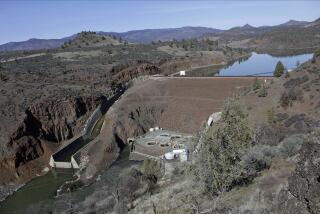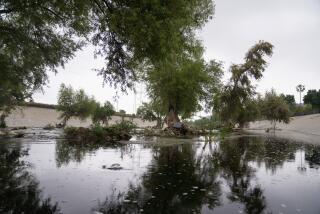Exploring a River’s Depths
- Share via
Formed by saltwater currents from the Atlantic Ocean mixing with fresh water from the Adirondack Mountains, the Hudson River is only 315 miles long. Yet the waterway located in the Northeast corner of the United States has been called America’s river, inspiring artists and writers and serving as a major transportation venue for the young nation.
The Hudson has also been the victim of over-commercialization and pollution. Even today, because of the incessant dumping of industrial chemical PCBs into the water, the fish are contaminated.
For the record:
12:00 a.m. April 24, 2002 FOR THE RECORD
Los Angeles Times Wednesday April 24, 2002 Home Edition Main News Part A Page 2 A2 Desk 1 inches; 23 words Type of Material: Correction
TV Times--The cover of this week’s TV Times gives the impression that the photograph is of the Hudson River. It is actually of the Ausable River in upstate New York.
With such a colorful and controversial history, it’s no wonder that the river is now the subject of a four-hour PBS documentary, “Amer- ica’s First River: Bill Moyers on the Hudson,” arriving Tuesday.
Moyers says he never paid much attention to the Hudson, though he’s lived in New York City for more than 30 years. “But one day, maybe four or five years ago, my wife and I were crossing the George Washington Bridge above the Hudson. It was a beautiful day, and the river was spread out before us on both sides of the bridge. We said, ‘We don’t know much about that river.’ We began to take a couple of trips and look at it more closely.”
It took Moyers 18 months to raise the funds for the documentary, an additional year to research the topic. “We put together this first-class team and it took us two years to produce it,” he says. “This is the end of a four-year project, which is a gamble.”
It’s a gamble, Moyers says, because he wasn’t sure how to make a documentary about the river interesting to the rest of the nation.
“We decided the one way to do it was to make a good, beautiful television show, because people like to watch beautiful things on television,” he says. “The second was to try to let people who didn’t know just what an important part the river has played in this country’s development and evolution. It’s home to many of America’s firsts.”
Moyers hopes viewers around the country will look at their local rivers, streams and lakes with “fresh eyes, just as I have looked at this river with fresh eyes.”
The first two hours of the documentary examine the role the Hudson River played in the development of the country’s economy, culture, literature, art and ideology. The river was also the site of one of the major victories over the British during the American Revolution--the bluffs where the river narrows at West Point.
The Catskill Mountains inspired the satires of writer Washington Irving and the adventure tales of James Fenimore Cooper, along with such seminal landscape painters as Thomas Cole.
The first part of the documentary also looks at the vast industrialization that took place along the river and explores the roots of the conservation movement.
“The second evening is about the difference citizens can make when they care and love something enough,” Moyers says. People such as Robert Boyle, “who was a journalist working for Sports Illustrated who took this [environmental crusade] on. It only takes a small group of dedicated citizens to make a difference.”
Boyle recalls that in the 1960s, the Hudson was in such poor shape that it was a staple for humor in Johnny Carson’s monologue on “The Tonight Show.”
“There were very few people involved in the Hudson [conservation effort] at that time,” he says. “The pollution was rampant. At that time, pollution was considered part of the American progress. I recall a U.S. senator said at one point in the ‘60s, ‘God made rivers to carry away man’s waste.’ I also remember when the group called the American Geographical Society put out a map of rivers of the East Coast, the Hudson was black. I called them up and said, ‘Why?’ They said it was because it was an industrial river. I said, ‘By whose authority?’”
Angered at the plight of the river, Boyle and a partner formed the Hudson River Fisherman’s Assn. in 1966 to go after the polluters. And he has never stopped his fight. “The one thing you can say about the people I have known on the Hudson River over the years is that they have persistence,” he says. “You have got the knowledge; you have got the smarts. What you really need to back it up is persistence.”
“America’s First River: Bill Moyers on the Hudson” can be seen at 9 p.m. Tuesday and Wednesday on KCET and KVCR.
More to Read
Sign up for The Wild
We’ll help you find the best places to hike, bike and run, as well as the perfect silent spots for meditation and yoga.
You may occasionally receive promotional content from the Los Angeles Times.







